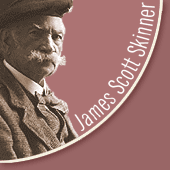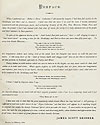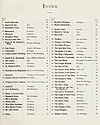




Please click any thumbnail image to view the full details.
There are 900 entries.
prev 10 | 69 > 70 > 71 > 72 > 73 > 74 > 75 > 76 > 77 > 78 | next 10 of 90 pages
| Image | Title | Item Description |
|---|---|---|
 JSS0744 |
Preface, The Elgin Collection | Here, Skinner talks about his love of the traditional music and scenery of North East Scotland in particular. There was a large surge of patriotic nationalism in many European countries towards the end of the nineteenth century. Through his own Nationalist sentiments, Skinner was very much a part of this international movement. |
 JSS0745 |
Index, The Elgin Collection | The index to Skinner's Elgin Collection shows that more than half of the pieces listed are strathspeys. It is no wonder that Skinner earned himself the title, 'The Strathspey King'. |
 JSS0746 |
Balmoral Schottische | When he write this tune, Skinner was still a dancing master. He was in the enviable position of being able to make up his own tunes to go with the dances he taught. When he composed the Balmoral Schottische, possibly when he taught there, in 1868, the Scottische was still a relatively new dance in Scotland. |
 JSS0747 |
Glenlivet | Glenlivet is described as a Strathspey or Highland Scottische, which shows the similarity between the two rhythms. It also shows that Skinner intended Glenlivet as a dance tune rather than a 'listening' tune. |
 JSS0748 |
Skinner's 'The 45' | Jacobite sentiment saw yet another rise in popularity towards the end of the nineteenth century. This one of Skinner's contributions. |
 JSS0749 |
I'll Aye be Fond o' Ingram | The Ingram in the title was G G Ingram from Huntly, Aberdeenshire, a journalist and great friend of Skinner's. Under the pseudonym 'Gramin' he wrote many lyrics for Skinner's tunes. |
 JSS0750 |
The Flower o' the Quern | The slow air, The Flower o' the Quern appears in many compilations of Scots fiddle music, and is still played extensively today. |
 JSS0751 |
Alexander Troup | Like Skinner, Alexander Troup also taught and composed fiddle tunes. In Skinner's manuscript collection of the Harp & Claymore (JSS001-JSS0226), Troup writes many comments. One of his own melodies is also included in the Harp & Claymore Collection. |
 JSS0752 |
Star Dust | As a dancing master, Skinner was perfectly placed to write music for his pupils to dance to. He very possibly premiered some of these pieces at the end of term balls or 'assemblies', where pupils, prospective pupils and parents would gather. You can hear part of this melody if you watch the Polka video clip. |
 JSS0753 |
Adnil's Mazurka | It was not unusual that Skinner should compose a Mazurka - when he was teaching dance between the 1860s and the early 1890s, the Mazurka was an extremely popular ballroom dance. |
prev 10 | 69 > 70 > 71 > 72 > 73 > 74 > 75 > 76 > 77 > 78 | next 10 of 90 pages


Historic Collections · Kings
College · Old Aberdeen · AB24 3SW
Tel:(0)44 1224 274312 · E-mail: scottskinner@abdn.ac.uk
Page design by IT Services Web Team